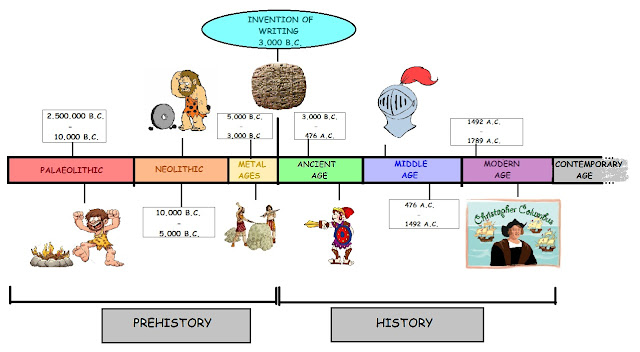Unit 6. Prehistory
Hello everybody!
Here you have the complete history timeline:
REMEMBER: For our test we only need to study the PREHISTORY part:
Here you have the main characteristics you need to know from each period:
PREHISTORY
Prehistoric times started with the first human beings, about 2.500.000 years B.C. and ended about 3.000 years B.C. with the invention of writing. Prehistoric times are divided into three periods: PALAEOLITHIC, MESOLITHIC, NEOLITHIC AND METAL AGES.
STONE AGE
PALAEOLITHIC
- The Palaeolithic time started 2.500.000 years B.C. and ended 10.000 years B.C.
- They lived in caves and huts.
- They were nomads (they travelled to hunt and find food).
- Palaeolithic people lived in tribes (small groups formed by families).
- They hunted and collected fruits.
- They painted in the caves’ walls.They discovered fire.
- They wore animal skins and fur.
- They used tools made of stone, bone and wood.
- Palaeolithic time ended when people stopped being nomadic (they stopped travelling).
MESOLITHIC
- The transition period between the Palaeolithic and the Neolithic (10000-5500 B.C). I was a gradual process.
NEOLITHIC
- Neolithic time started 10.000 years B.C.
- They discovered agriculture and farming.
- People become sedentary because they cultivated the land and domesticated animals:
- Crops: wheat and chickpeas
- Animals: dogs, goats, sheeps and pigs.
- They built small villages near rivers to access to water for crops and animals.
- They invented ceramic, pottery and fabric.
- They invented the wheel.
- Neolithic ended 5.000 years B.C.
METAL AGES
- Metal ages started about 5.000 years B.C.
- They started to use different metals to make stronger tools:
- Copper age: they learned how to use cooper. Communities were divided tasks: farmers and metal workers.
- Bronze age: they learned how to make Bronze. Tools were stronger.
- Iron age: they learned how to use iron, which is easier to find in nature. Weapons were harder and had better quality. Larger settlements of houses with large hill forts were built for protection.
- Metallurgy started and they did firearms, tools and decorations.
- Trades made some villages grow in size turning into cities.This created large commercial and cultural exchange between these new cities and new inventions such as sail boats and wagons.
- They created social classes, the rich and the poor, the powerful and the slaves.
- Constructions called megaliths were created with large blocks of Stone: Menhir and Dolmen.
- The Metal Ages ended with the appearance of writing about 3.000 years B.C.
And the videos we have seen in class:
PRE-ROMAN PEOPLE ON THE IBERIAN PENINSULA
THE CELTS.
- The Celts spread across Europe during the Iron Age. Those who settled on the Iberian Peninsula lived in the north- west and in central areas.
- They lived in rural communities. Fortified villages called castros.
- Archaeologists have found manu Celtic structures and artefacts, including coins, jewellery and even sculptures such as Los Toros de Guisando.
THE IBERIANS
- The Iberians inhabited the east and south-east of the Iberian Peninsula, starting from the Bronze Age.
- Contact with other cultures led to developments such as urban settlements.
- They created great sculptures like the Dama de Elche.
- They used large rocks to construct megaliths for burials.


Comentarios
Publicar un comentario